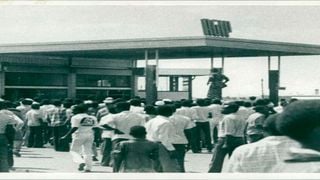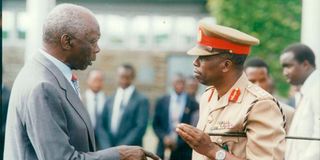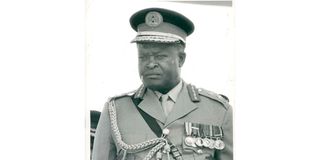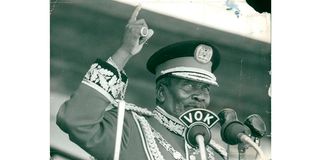
A Kenya Air Force rebel on top of a car addresses a crowd at Kariobangi Petrol Station on August 1, 1982.
| File | Nation Media GroupNews
Premium
From colonialists to Kenyatta government: The mutineers that shaped the country
What you need to know:
- The earliest recorded military revolt happened in Baringo on September 23, 1897 when Nubian soldiers staged a mutiny at Eldama Ravine
- Declassified records by the British government show that Kenya had at least three mutinies before the famous 1982 coup attempt against Moi.
The attempted military coup on August 1, 1982 remains one of Kenya’s defining moments 39 years later. Perhaps what makes it more memorable is that, according to many expert accounts, it is thought to have resulted in — or at least accelerated — President Daniel arap Moi being a less tolerant leader four years after he succeeded Mzee Jomo Kenyatta, and Kenya turning into a more authoritarian State.
However, this was not the only military revolt in Kenya’s history and previously confidential documents seen by the Sunday Nation have revealed details of previous incidents that would have changed the country’s course.
For a start, a mutiny is a revolt by soldiers to express their grievances by defying the authority, while a coup is a rebellion led by the military and some time the political elites to oust the government.
Nevertheless, they all denote armed outbreak against powers in authority. If not dealt with in time, mutinies can escalate to coups. Such was the case in Burkina Faso in 2012, and in Sierra Leone in 1992.
The 1897 mutiny at Eldama Ravine
The earliest recorded military revolt in the area now known as Kenya happened in Baringo on September 23, 1897 when Nubian soldiers serving in the East Africa Rifles staged a mutiny at Eldama Ravine and broke their allegiance to the British. They wanted better pay, clothes and to have their wives accompany them to expeditions.
The soldiers were to accompany James MacDonald who had been sent by the Foreign Office to review the northern boundaries around Lake Turkana after the British feared the French and the Italians would claim the territory.
Under their leader captain Mabruk Effendi, the African soldiers then began marching towards Uganda to present their grievances to their commandant. On reaching Kapsabet, they arrested and detained the District Commissioner Captain Bagnall, who had decided to stay put despite being warned of the danger. They also burnt alive 100 Nandi residents in revenge for the murder of three of their colleagues.
Their next target was Mumias where the District Commissioner Stanley Tomkins had already been warned by runners about a looming attack. Since Mumias station was undermanned, the government official turned to King Nabongo Mumia, who responded by providing 1,000 spearmen.
The mutineers arrived in Mumias as expected and ordered the District Commissioner to give them food. The DC acceded to their demands and they proceeded to Uganda without a fight.
The British feared that the mutiny could complicate the situation in Buganda where they had just deposed King Kabaka Mwanga II, for rejecting their influence. It later turned out that the mutineers had already hatched a plan to stage a coup and reinstall King Mwanga II with some of them being appointed to senior positions. Urgent steps, therefore, had to be taken by the British to prevent the mutineers from reaching Buganda.
It took the British five months to crush the mutiny with the help of Indian soldiers who had been brought in hurriedly from India through Mombasa.
The British began considering plans to reorganise the army and to review the kind of soldiers they needed in East Africa. They made attempts to recruit the Zulus but the South African government refused. At the same time, recruiting Indians to serve in East Africa was considered too expensive.
In the end the colonialists came to the conclusion that Nubian soldiers were still the best. They were not only brave, but also cheap to maintain. However, other natives such as the Swahili and the Somalis were to be recruited into the battalions to reduce their influence. Salaries were also increased from 10 to 18 Rupees per month.
The 1964 mutiny at Lanet
In January 1964, just a month after independence, there was growing discontent in the Kenya Army over low pay and European officers who still held senior positions. Similar grievances had just led to mutinies by the armies of Tanganyika and Uganda.
According to previously restricted court martial documents and witness testimonies seen by the Sunday Nation, the British Intelligence had already taken note of the disquiet among Kenya Army soldiers of the 11 Battalion Kenya Rifles based at Giffard Barracks, Lanet.
As a result, Lieutenant-Colonel Patrick Michael Victory, the commanding officer 3 Regiment of British Army’s Royal Horse artillery (3 RHA) based at Gilgil was instructed to keep an eye on Giffard Barracks Lanet, and be ready to take responsibility if anything happened.
Acting on this tip off, Lt-Col Victory sent a battery of soldiers on a tactical mission at Lanet. The soldiers were to pretend to be on an exercise at Lanet to stay in the vicinity of Giffard Barracks. This was to give them the opportunity to act in case of any trouble. According to the documents, the soldiers sent on the mission were only to move at night, and not go too near to the camp to conceal the mission.
Since early mutinies in Uganda and Tanganyika had led to better pay for African soldiers and the dismissal of European officers, the Kenya Army soldiers of 11 Battalion expected Prime Minister Jomo Kenyatta (who would later become President) to take cue from the two neighbouring countries and address their concerns in a live broadcast that was to be made on January 24, 1964 at night.
That same day Lt-Col Victory, who was tasked with keeping an eye on Giffard Barracks Lanet, received another tip off that trouble was likely to occur that night. After consultation with the Regional Police Officer and the Commanding Officer of 11 Kenya Rifes, two British sergeants of the 3 RHA Battery that had been monitoring the situation from outside were sneaked into the camp and placed at vantage point where they could observe the Battalion’s armoury.
They were equipped with thunder flashes and radio sets. In addition, one officer and a wireless telegraphy operator were also sneaked into the house of the European Commanding Officer of the Kenya Army’s 11 Kenya Rifles inside Giffards Barracks Lanet.
In case of any trouble, the two sergeants were to throw the thunder flashes and inform the Royal Horse Artillery at Gilgil if any attempt was made to break the armoury. Meanwhile, soldiers from the Royal Horse Artillery remained hidden in a bush 2 miles from Lanet Camp.
On the night of January 24, 1964, soldiers of 11 Battalion Kenya Rifle gathered in the TV room hoping to receive good news from Mzee Kenyatta. However, Kenyatta never appeared on TV as expected but instead his picture was put on the screen and a personal message from him was read by the presenter.
The message stated that a “committee was being set up to examine existing conditions and pay” , and that a general review of these aspects would be made on March 1, 1964.” The disappointed soldiers immediately stormed out of the TV room with some shouting “we have been cheated”. They went on the rampage, broke into the armoury and took arms.
The British soldiers from the Royal Horse Artillery who had been keeping an eye on the camp quickly swung into action by surrounding the camp and isolating the rebels. Using loud speakers, they warned the mutinying soldiers that they would sweep the camp with maximum force unless they surrendered.
Any soldier who defied the orders and tried to breach the lines was shot at straight-away. Killed in this way, according to the documents, was Private Simon Kiprop. Other British soldiers were quickly deployed to strategic points in Nairobi. They sealed off the Voice of Kenya, Nairobi telephone exchange, the overseas cable office, and Embakasi Airport.
Mzee Kenyatta had to swallow his nationalist pride and call for help from the British. At his request, the British government quickly dispatched 700 Royal Marine Commandos to Nairobi from the Royal Air Force Base at Lyneham Wiltshire. In Mombasa, Royal Navy ship Centaur docked with another 600 commandos and an unspecified number of jet fighters.
Rather than negotiate with rebel soldiers as Tanganyika and Uganda had done, Mzee Kenyatta took a firm stand warning that “those who took part in the Lanet incident have gravely broken military discipline and must be dealt with firmly”. He added: “I do not intend to meet them or allow any of my ministers to negotiate with them.”
It was thought the statement was targeted at Jaramogi Oginga Odinga after rumours emerged that he was on his way to negotiate with the rebels to lay down their arms.
The mutineers were disarmed the following day — January 25 , 1964 — after a brief exchange of fire. All recovered arms and ammunition were loaded into vehicle and sent to Gilgil. The Royal Horse Artillery then carried out a systematic sweep of the whole camp looking for soldiers and weapons.This was completed at 4.30pm.
All soldiers of the 11 Battalion Kenya Rifles below the rank of sergeant were paced under guard and the process of separating mutiny participants and non-participants began. In the end, at least 597 soldiers, mainly from Ukambani and the Rift Valley, were accused of participating in a mutiny. The 11 Kenya Rifles was also disbanded and a new 1 Kenya Rifles formed.
Those accused were categorised as red, yellow and green depending on the level of their participation in the mutiny. At least 158 in the yellow category were discharged and restricted in their home districts, while those in green numbering around 340 were allowed to rejoin the newly formed 1 Kenya Rifles. 99 in the red category were discharged and charged with mutiny. However, only 33 were prosecuted by the court martial whose president was Major Joseph Ndolo.
Among those who testified against the mutineers was 23-year-old Lt Daudi Chepkonga Tonje who later rose to become Chief of General Staff. Part of his testimony seen by this paper stated, “We finished dinner and went into the television room, sometime before 2100hrs, l heard a loud bang followed by two more loud bangs. I ran in a general direction towards ‘B’ Company. As I passed near the armoury, I heard some soldiers speaking in Kalenjin dialect. They sounded very excited and I heard the word bunduki (gun) mentioned.

In this file picture, President Daniel arap Moi confers with Chief of General Staff Daudi Tonje at the Jomo Kenyatta International Airport (JKIA) before leaving the country from an overseas trip.
“On arrival at B company, I passed a soldier who I immediately recognised as Gideon Musyoka and he was armed with a rifle. I have no doubt this man was Musyoka as I passed close to him and recognised him as one of my platoon riflemen.”
Tonje then requested Colour Sergeant Wambua to fetch him a microphone and a pressure lamp.
“Through the microphone I broadcasted that the actions of the mutineers were against the wishes of the Prime Minister and his government. I advised them to return to their rooms,” he said.
Some of the mutineers heard his message and booed him. On his way to his platoon line, a group of about 60 men ordered him to stop.
“I then heard a man say, ‘It is a Lieutenant of 5 platoon. You can come forward sir’.” He immediately recognised the man as private Mbuvi. As he walked slowly towards the men, he was again told to stop, and told to extinguish the lamp he was carrying but he refused. He tried reasoning with the group to no avail.
The now retired General then heard a voice of a man he recognised as Lcpl, Kiptigin’s saying “What are waiting for” At this point he was again ordered to extinguish the lamp. “But instead I placed it on the ground and walked away.” Behind him he heard someone say ,”Why don’t we put him in the guardroom.”
Nevertheless, the mutiny somehow achieved its goal. African majors were quickly promoted to take over the command of the battalions of the Kenya Army. Just three days after the mutiny, Major Jackson Mulinge was promoted to Lieutenant Colonel and made the commander of the 3 Kenya Rifles, replacing Lieutenant Colonel J.R. Anderson. He was the first African to command a battalion in Kenya. A couple of months later, Joseph Ndolo was appointed the commander of the 5 Kenya Rifles. In April, those serving in the military, the police and prisons received a pay rise.

Former KAF General the late Jackson Mulinge, who is credited with crushing the attempted coup of 1982.
To the British and the Kanu moderates, the mutiny provided them with the opportunity to drive a wedge between Kenyatta and Jaramogi despite admitting that there was no evidence linking the latter with the revolt.
According to a telegram marked “confidential” and “priority” on the same day the mutiny was crushed, the Security Liaison Officer of the British spy agency MI5 requested Governor General Sir Malcolm MacDonald to ask Mzee Kenyatta to dismiss Jaramogi from the Cabinet or “subject him to full Special Branch surveillance.”
On that very day, Cabinet Minister Tom Mboya visited Premier Kenyatta at Gatundu to urge action against Jaramogi, but Kenyatta “strongly rebuffed” him. Kenyatta whilst deeply concerned, resisted any steps against Jaramogi.
The 1971 coup plot
The attempt to oust Mzee Kenyatta was foiled at an early stage. It was said to be the brain child of Joseph Daniel Owino, who in 1964 had been implicated in the Lanet mutiny.
Unlike other military revolts in Kenya, the plot appeared to be well-organised and involved those in the top echelons of the military, politics and other sectors. Among those mentioned by the plotters were Chief Justice Maluki Kitili Mwendwa, Chief of Staff Major General David Ndolo and Gideon Mutiso the MP for Yatta, among others.
A document on the plot by the CIA reads, “The possibility that the military might become involved in politics is an entirely new factor that has developed as a result of the tribal tensions and government’s actions since the assassination of (Tom) Mboya (in 1969).”
The document also reveal Major General Ndolo was incensed by corruption in the government and the Kikuyu tribal oathing that had been extended to the military.
The role of Mutiso, who became chairman of the revolutionary council, was to liaise with senior officials sympathetic to the plot, key among them Major General Ndolo. Eliud Langat was tasked with collecting intelligence information from the GSU since he had good connections in the unit.
The GSU was considered the only threat as it had also been trained in counter insurgency. Secretary-General of the Kenya Railways Union John Mollo was to mobilise the labour movement.
The role of subverting dissidents within the military was left to Israeli-trained jet fighter pilot Captain Frederick Coleman Omondi, 27. And, Makerere University lecturer Dr Joseph Ouma Muga was tasked with soliciting support for the planned coup from foreign embassies and neighbouring countries.

Mzee Jomo Kenyatta, dressed in full military uniform, attends Jamhuri Day celebrations of December 12, 1971.
One of the first acts of the conspirators, was to contact Mrs Pamela Mboya, the assassinated politician’s widow. They wanted her to connect them with Irving Brown, an American trade unionist whose friendship with Tom Mboya dated back to the 1950s.
Brown, who was known to mobilise huge amounts of funding, was the key man in CIA’s manipulation of African trade union movements, and played a great in splintering communist led movements.
Declassified documents, for example, show how he delivered huge sums of money to Mboya in 1958. The close links Between Mboya and Brown made Kenyatta uncomfortable. Following Mboya’s assassination, the conspirators were sure Brown would be sympathetic to their plot and provide funds.
It was revealed in court that while Pamela Mboya said she supported the idea of a coup she did not want to get involved. She, however, wrote an introductory covering note on the conspirator’s letter to Brown — who refused to get involved. The conspirators also approached Russian Embassy and Tanzania government for funds.
In a statement revealed in court, Dr Ouma admitted that he had met Tanzanian President Julius Nyerere, and asked him for 39 machine guns, $90,000 and a Tanzanian military presence near the Kenyan border.
But Nyerere replied, “Not against Mzee’s government. If it was Malawi I would have thought about it.” Nyerere would later leak the plot to Kenya, according to one of the conspirators Coleman Omondi in a later interview.
While top officials sympathetic to the plot such as Major General Ndolo and Chief Justice Mwendwa were retired from the government, the other plotters were jailed for a period between 7 to 10 years.
The writer is a London-based Kenyan researcher and journalist.





